The Kenda Alluvium Pro is a gravel and adventure tyre that is claimed to be as capable on pavement as it is on hard single-track trails.
Designed with speed in mind for dirt and gravel road riding, they come with either tan or black sidewalls, in four different sizes - 700 x 35, 40 & 45mm and 650B x 45mm.
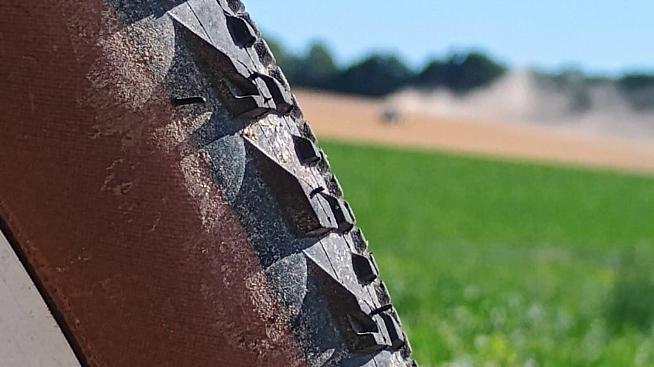
The Alluvium Pro features a range of TLA (Three Letter Acronym) technologies that you can bamboozle your friends with. Your more gravel-literate pals may be aware that 'TLR' is the industry standard abbreviation for 'Tubeless Ready', but only a true rubber aficionado will know that 'RHP' means the tyre comes with a 'Reflective Hot Patch' on the side of the tyre that generates better visibility in low light.
As for 'GCT'? Well that's Kenda's 'Gravel Casing Technology', which is the bead-to-bead casing which protects the tyre from cuts and punctures, and allows easy tubeless conversion. Easily impressed by such things, I opted for a pair of gumwalled 700x40c tyres to test out during the summer on some PGR (planned gravel rides).
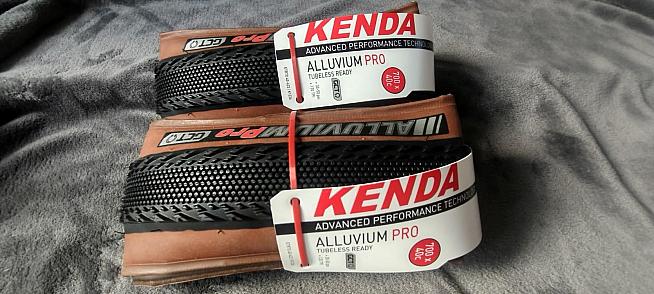
A few years ago, there was an internet-fuelled debate about whether there were more doors or wheels on the planet. Naturally, it was far from an open-and-shut case: the debate went around in circles, with advocates on both sides coming up with well-reasoned arguments for why they were right, whilst brushing aside equally sensible counter-arguments.
Of course, if the question posed had instead been 'Are there more doors than tyres on the planet?' there would have been no debate. Because, as every cyclist knows, it is an undeniably fact that there are more bike tyres than there are atoms in the universe.
In the same way that in a period spanning 20 years Leonardo DiCaprio has had eight different girlfriends who have never exceeded 25 years of age, I have amassed a huge number of pairs of Cyclo-X or Gravel tyres in a similar time. Like DiCaprio, I don't bother waiting until a set gets old, saggy and worn out before opting for a fresh new pair. My head is easily turned by the sight and smell of new rubber - a weakness ruthlessly exploited by Google's advertising algorithms.
Unlike Leonardo, however, I do keep hold of my old tyres. I'm fond of all of them, and keep them stored in a big black plastic trunk in the back garden. I like to think that they are growing more supple with age, and that one day I will find a use for them, like the half-worn brake blocks I also find so hard to throw away.
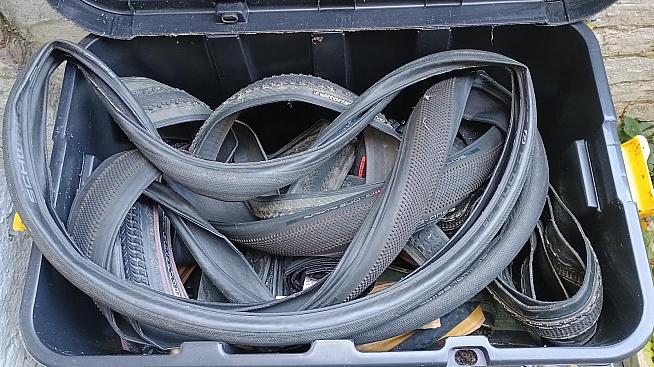
When my test pair of Kendas arrived in June, I was quick to consciously uncouple my Vittoria Terreno Drys from my bike to the black trunk. At that time, the off-road trails were firming up. Britain was experiencing the first flush of summer, whilst also suffering from a bad case of election fever, as politicians from both ends of the political spectrum paraded themselves on TV and Radio.
With the familiar 'aggressive knobs' at one end of the scale, and 'smooth and slick' performers at the other, it's fair to say that the tread and design of the Alluvium Pros makes them suited to the middle ground of the gravel-tyre spectrum.
First impressions were favourable, as the Alluviums were by far the easiest tubeless ready tyres I have ever mounted on a set of wheels. In fact, they almost slipped onto the rims. No levers were needed, no need to warm them up on a radiator first, or lube them with washing-up liquid.
They went on so easily in fact, I feared there was no way that they'd form an air-tight seal with the rim. This worry was unfounded. They popped on easily, and retained air well once coated and topped up with Lifeline Sealant. They looked perfect for a first test ride on the hard-packed chalk of the South Downs Way.
The South Downs Way (SDW) is an ancient trail that stretches 100 miles across the South of England from Winchester to Eastbourne. Its tracks have been used for some eight thousand years, and are made up of white chalk studded with the flintstones that were first mined 4000 years ago by, well, The Flintstones. The SDW is a dream to ride on in the summer as long as you are aware of the myriad of ways it can destroy you, your bike and your tyres.
The soft white chalk is easily carved into steep-sided ruts by the water that runs down it - ruts as deep as your bottom bracket in places. Although the tyre's tread is made from a single rubber compound, the knobs on the edge of the tyres did a decent enough job of gripping the sides of these ruts to help me escape them, without having to dismount the bike.

When moist, the chalk becomes greasy to ride on, and is made even more slippery by the polished surfaces of the flint pebbles. Although exposed sections of the trail are bone dry in the summer, parts that pass through forests can hold onto morning dew for several hours even on the hottest days. With a total elevation gain of almost 4000 metres, there is a lot of time spent riding up steep trails. Careful weight distribution and good tyre traction is needed to keep you moving without spinning the rear wheel, or unweighting the front.
Here, the low profile knobs in the centre of the Alluvium Pros made a good fist of gripping the chalky surface on these climbs when it was dry, but struggled to get any traction wherever there was moisture. This led to me having to dismount on some of the steeper wetter sections. To be fair, however, friends who rode with me that day on full-sus and hardtail mountain bikes with softer, chunkier off-road tyres (such as Maxxis Minions), also ended up dismounting further along the same trails due to a lack of grip, so at least the thinner, harder Kendas on my gravel bike failed in good company.
The most impressive feature of the Alluviums that day was their durability. Broken flints are littered all over the Downs. They have razor-sharp edges that can slash through any number of hi-tech rubber compounds easily, but the tyres lasted the whole hundred miles without a single scratch on them. Nor was there any sign of the tell-tale streaks of sealant on my frame to indicate any punctures. I was testing the tyres on a brand new set of black-rimmed BORG wheels, and although the rims had several gouges in the paint from where they had struck flints, the sidewalls showed zero sign of damage.

When dry, the chalk on the Downs easily crumbles to form a fine dusty gravel path that is a dream to ride on, and on this terrain the Alluviums really did perform well. They gave enough traction to give me the confidence to hit these trails at speed, without feeling that the tyres were sapping my energy by being over-grippy. When I did have to adjust my line quickly to avoid a rut or pothole, the tyres gave me the necessary grip without the fear of sliding out.
It's fair to say that the Alluviums easily passed the South Downs Way summer test, although I would be sticking to my fatter, knobbier and slower 'Rock n Rolls' for the Autumn to Spring rides when the chalk would be wet and sloppy.
Off-road then, the Alluviums were great in the summer, but how were they on road?
I had planned a week-long bike-packing trip in Norway that covered about 400 miles of riding on an equal mix of gravel and tarmac. I had no concerns about the tyres coping with the off-road sections, as I'd been told that there was nothing harder than the South Downs, and that although the trails might get wet, they wouldn't get muddy or claggy in the rain. However, it was using the Alluviums on my round-town commuter bike that put me off taking them on the trip to Norway. They coped well enough on the pot-holed roads around Brighton, but as soon as I pushed the speed up I felt like I was wasting watts from the way they gripped and buzzed along the tarmac.
So, for the Norway trip, I switched the Kendas for my tried and tested Schwalbe G One Speeds, which, as the name indicates, are a faster tyre on the tarmac but of course less grippy off road. I'm sure I could have completed the tour with the Kenda tyres, I just think that I might have started cursing their dragginess on the roads as I got more tired through the week - especially on some of the endless switchback roads that took you up the mountains.
The Wolf Way
Instead, I felt the Alluviums would be better suited to another bike-packing trip I had planned - a leisurely five-day ride along the 250 mile Wolf Way in Suffolk with my wife.
After the ups and downs of the SDW, this trip tested the tyres in a different way, with many of the off-road sections being covered with clods of earth or sand. In some places the surface of the trails would be hard-packed with a light dusting of sand which had spilled over from the edge of a field, but in other areas nearer to the coast, the sand was thick and rutted.
With a fully-laden bike I didn't want the tyres inflated any lower than the minimum 30psi. Even at this relatively high pressure, there was enough grip and flexibility in the tyre for it to bite into the sand with minimal fish-tailing from the back wheel or heart-stopping front wheel slides on the corners.
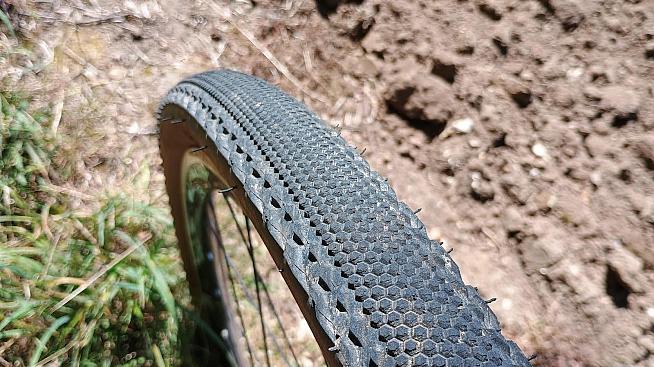
It stayed delightfully sunny for the whole five days of our trip, but thanks to many of the trails passing near heavily irrigated fields, I got to see how well the tyres could cope when the ground was wet. This also gave me the perfect excuse to ride through any puddles we found rather than ride round them. Again, the tyres did an admirable job, providing enough grip when it was needed without holding onto the mud and blocking up the tread of the tyre.
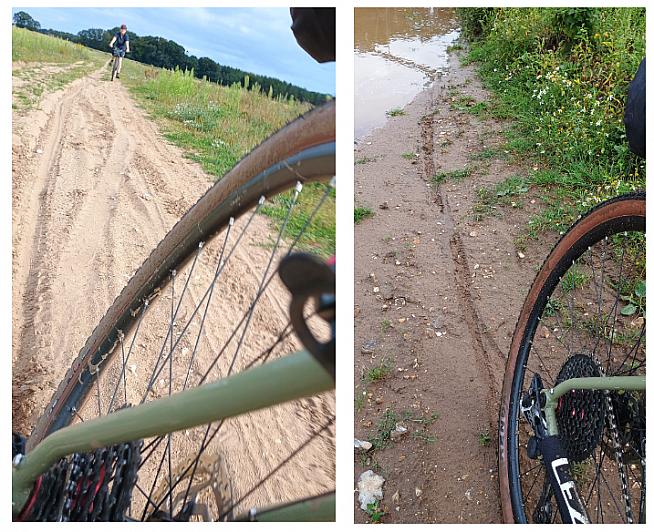
From Ipswich to Felixstowe the Wolf Way closely follows the River Orwell. When we rode this section the falling tide exposed wide flattened sandscapes. This sea-soaked sand was compact enough to be ridden on, as the Alluviums provided just enough grip and cushioning for an exploration of the shoreline.
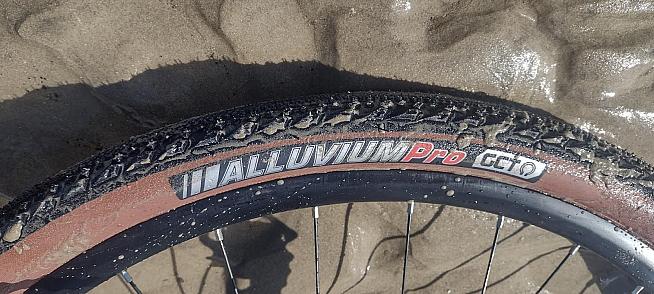
The Wolf Way trip was a slowly ridden blast which in my mind proved the first half of the adage that 'riding a bicycle makes adults feel like children and children feel like adults'. The tyres certainly felt like they encouraged me to explore the less-trodden path.
So, what's my overall verdict after three fairly dry months of testing?
Well, if you are looking for a tyre for getting to grips with gravel riding over the summer months, the Alluviums are definitely a candidate worth considering. They are super easy to fit tubeless, tough enough to withstand the sharpest of trails, but soft enough to give you a sure grip even on the loosest of surfaces.
If you are not in a hurry, have watts to spare, or a low proportion of tarmac on your routes, they can be used on the road, but are probably too draggy for lots of long hard days on a highway.

As a mid-summer tyre, rather than a middle-of-the-road tyre the Kenda Alluvium Pro get my vote. They'll be stored away when it gets wet in the Autumn, but unless something more attractive catches my eye, I'll be fondly fishing them out of my big black trunk when the sun comes out again next summer.
Kenda Alluvium Pro Gravel Tyre, £50 - bicycle.kendatire.com
0 Comments





